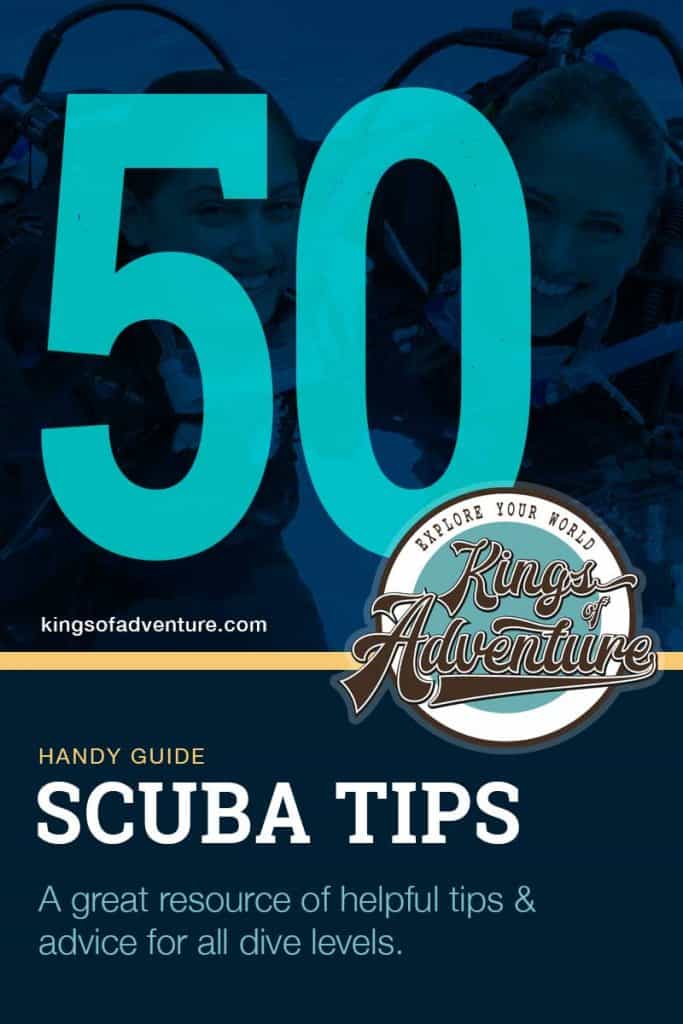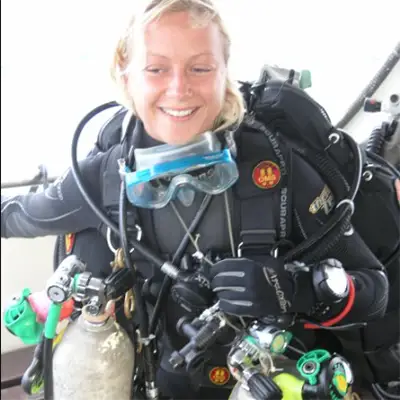There’s plenty of advice online to offer you scuba diving tips, but we’ve narrowed it down to the key points so that you don’t have to search everywhere. Our 50 scuba tips cover buoyancy and air consumption, pre-dive procedures, navigation, general safety, diving in current or from a boat or the shore, ear health, marine life, and underwater photography.
Buoyancy and Air Consumption
1 Check your weight. The more weight you are carrying, the more effort you need to push yourself through the water. You’ll need more air in your BCD which will make you less streamlined. More drag means more effort which in turn means greater air consumption. Further, the air in your BCD will be more reactive to depth change which makes your position harder to control.
2. Don’t overweight to get down, observe good technique instead. Wet and ‘fill’ a dry wetsuit. Make sure you are perfectly straight and upright to minimize drag – that includes your fins. Lean slightly back with your deflator hose extended when releasing air. Some divers wrap their other arm around themselves to squeeze the air out of their jacket. Stop kicking your legs and empty your lungs and wait for a beat for your descent to start. Once the water starts to compress your gear, your speed will increase so be ready to respond. Consider these techniques when dumping air underwater too.
3. Stop using your arms, not only will your flapping waste air, it’s impossible to achieve neutral buoyancy unless you are still. Your legs power your fins, so you don’t need your arms for propulsion. If you are using your arms, it’s most likely an instinctive reaction to help with your buoyancy or trim. Consider what you are trying to achieve and make the adjustments with breath control or your BCD.
4. Check your position and streamlining. The most efficient way to move through the water is horizontally with your gear streamlined to reduce drag. Not only will this take the least effort and reduce air consumption it will also ensure that an even depth is maintained which will mean air spaces will not expand and cause an ascent.
5. Slow down, you’ll not only see more, but you will breathe less. Relax and stop thinking about your gauge. Enjoy your time underwater and don’t stress. If you’re anxious, your breathing rate increases. The more you dive, the more you’ll become at ease, and your air consumption will naturally decrease. Yoga and meditation can help increase your sense of calm.
Pre Dive
6. Make sure you, and everyone on the dive, is aware of any scuba diving dangers, what to do in an emergency, and where any safety equipment is stored. Having a clear plan reduces response time and stress and increases the likelihood of a calm, well-managed emergency
7. Pack your gear in your dive bag in the order you will need it so that the thing you need last goes on the bottom. This method keeps you organized and tidy and is particularly important on dive boats when space can be a luxury. Make sure you have the appropriate spares in your save a dive kit.
8. Find out about the site you are diving. The more information you have, the more you will get out of the dive and also the safer you will be. If it’s not an organized trip with a briefing, talk to others who have dived there before and make sure to review weather and sea conditions.
9. Make a plan and review hand signals. The more you discuss top side, the less confusing it will be underwater and the more enjoyment you will get from the dive.
10. Do a buddy check. It may seem like something you do only on a course but, apart from checking that everything is working, it familiarizes you with your buddy’s gear and vice versa. This knowledge could save valuable seconds in an emergency.
Navigation
11. Know what your buddy and the divers on your team look like underwater. Check out their fin and mask color and look for distinctive logos or unusual gear. These observations will help you recognize people underwater which is useful if you are looking for team members, if you have lost the group, or for making sure you are following the right person
12. Take a good look around on the surface; mooring lines, boats, the sun, piers, kelp, wave direction and buoys can all be seen below water too. Knowing where they are on the surface will help you understand where you are when you encounter them underwater.
13. Take a map with you underwater. You can copy a sitemap onto a slate which will help you remember the features of the location. Orientate yourself on the surface and as you descend. Look for memorable features and don’t forget to look up and behind you to aid your recognition as you move around. Learn about the reef because the more features you can identify the more likely it is to be memorable.

14. Compasses are an obvious tool for helping with navigation but don’t forget to check your depth. Increasing or decreasing depth can give you as much of an indication as to your location and direction of travel as the points on the compass.
15. Keep it simple and take it slowly. You want to enjoy the dive and not stress about navigation for the whole time underwater. If you can follow a reef edge out and back, perfect. If you need to use a compass, then locate an obvious marker ahead of you in the direction you want to go. Swim to it, enjoying what you see on the way. Once you get there, use your compass to pick another point and move on. This way you don’t need to follow your compass for the whole dive but can still navigate the dive out and back.
Safety
16. Being able to be seen and found is key to your safety on the surface. It’s essential that you have some kind of surface marker and a whistle and you should consider a personal locator beacon.
17. Your dive equipment is your life support. Check your gauges often. Look after your gear; a broken fin or mask strap could start a chain of events leading to an emergency situation as easily as a poorly maintained BCD. Have the right gear for the dive and the appropriate exposure protection for the water temperature. Being cold is not fun, and you want to make sure that you will be warm enough if you happen to spend more time in the water than planned. Test new gear in shallow and calm conditions.
18. Keep your skills and knowledge up to date and refreshed. Regulator recovery, mask clearing, cramp removal, out of air drills and practicing donning and doffing your gear are not just for your course, practice them so that if required your reactions are fluid and instinctive. Take or refresh CPR and first aid training which will give you confidence should you need them. If you can’t remember what nitrogen narcosis is, or oxygen toxicity, or what the signs and symptoms of carbon monoxide poisoning are– look them up.
19. Look after your health and make sure that you are both well and fit enough to dive. Don’t dive if you feel like you are coming down with something, hungover, tired or not hydrated. You don’t need to be fanatical about fitness, but you do need to have the strength and stamina to comfortably deal with current and an unexpected surface swim. Being mentally prepared to dive is as important; trust your instincts, if it doesn’t feel right, or you don’t feel ready for the type of dive on offer have the confidence to sit it out. Don’t be pressured but understand what your concerns were. Did you need more information or more experience, skills or training?
20. Don’t get complacent with decompression guidelines; stay within limits, make slow ascents, do safety stops and make sure you’re hydrated. Know how to plan your dives safely by whatever method you use and remember to review no-fly times. Review signs and symptoms associated with decompression illness and make sure you know how to respond. If you’re a complete beginner and wondering what is the bends, you should check out our in-depth article.
Diving in Current
21. Unless it’s a planned drift dive, always start your dive heading into the current. This ensures that you have enough air and strength for your return.
22. Current can change. Watch the fish, they swim head into the current too, and the more frantic they are, the stronger the current is. If you notice their behavior change, it will tell you that the current is changing too. Divers bubbles will also give you a clue as to the strength and direction of the current.
23. Current is weaker nearer the bottom or close to the reef, keep yourself tucked in and sheltered rather than out in the blue and you will find it easier to deal with.
24. When dealing with current on the surface remember that dropping your weights, swimming across the direction of the current or descending are all ways that you can make the situation easier. Never be afraid to signal for help. It’s better to do this before a problem occurs.
25. Down currents are very frightening but often localized. Try and swim away and out of it horizontally rather than battling to swim up. Inflate your BCD and drop your weights and be ready to take measures to slow your ascent.
Boat Diving
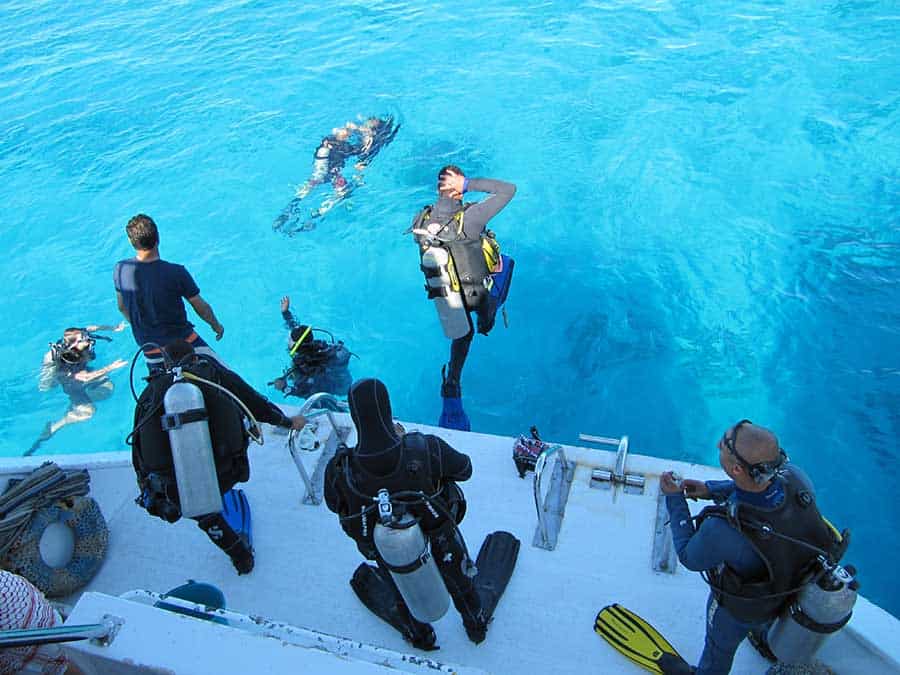
26. Keep your gear tidy and safely stowed, this will save you losing gear or it getting broken if waves rock the boat. Being organized also ensures you can kit up and get in the water efficiently.
27. It’s easier to understand the entry and exit protocol before you get kitted up; so take a look and ask for guidance if you aren’t sure.
28. Dealing with seasickness is trial and error to find out what works best for you, yet it can strike without warning. Making sure you are hydrated, well rested and not hungry helps. If you’re feeling unwell move to the steadiest part of the boat, keep in the fresh air, focus on the horizon and make sure you are downwind if you need to feed the fish.
29. Make sure you are prepared for dealing with the elements. In hot weather, you’ll want to make sure you have sun protection, a hat, sunglasses and plenty of water. In cold weather, you’ll want a wooly hat and warm, waterproof dry clothing and hot drinks.
30. When surfacing, make sure you listen for overhead traffic and pay attention to any special directions that were given. Often, it’s safer to surface close to the reef and then surface swim out a ways to meet the boat for a pickup.
Shore Diving
31. When entering the water always make sure you have your mask on and regulator in and that your BCD is inflated. If the water is calm you may choose to put your fins on in the water, otherwise shuffling backward or sidestepping with your fins on is the way to go. Shuffle your feet to ensure you don’t step on and hopefully frighten away any spiny marine-life. Work with your buddy, so you support each other and if you fall, don’t try to get up. Swim as soon as you can; it’s easier than shuffling fully kitted up.
32. Surface swims to the descent point are quite common when shore diving. Remember you can use your snorkel to conserve air when swimming face into the water but note that for longer swims, you might find swimming on your back easier. Be aware though that it’s easy to scoop water into your snorkel when swimming on your back.
33. Surge is a back and forth action caused by waves, and while it can happen at any shallow or coastal site, it’s more common on a shore dive. On the whole, the water movement moves you back and forth like a swing returning you to your original position, but be aware of diving too close to the reef or rocks. Maintain your buoyancy and don’t fight it.
34. Stay alert to changing conditions remembering that you have to get in through the surf zone. Consider a backup exit point in case this happens.
35. Exiting the water on a shore dive is tiring, be conservative when it comes to reserves of air and strength for getting back to shore. Approach exiting calmly and slowly and keep all your gear in place until you are safely on shore. Swim as far as you can and when standing be prepared for the sudden weight increase. Use your buddy for assistance and make sure you can comfortably stand before deciding whether to remove your fins. Whatever you choose, remember to shuffle not step your way to the water’s edge.
Ears
36. Taking it slowly and equalizing early, often and not forcibly will help protect your ears. Do not continue down if you can’t equalize. Making a pre-dive plan for equalizing problems reduces stress and confusion so speak up if you have concerns
37. If you’re prone to infection, rinse your ears with fresh water but don’t use cotton buds to clean them. Cotton buds can cause unintentional damage and can leave fibers behind that can fester.
38. Don’t dive if you have a cold and don’t use a decongestant as it can wear off underwater.
39. When dealing with a reverse block, it’s important not to panic. The pain is caused by expanding air not being able to escape. To compress the air and relieve the pain, descend a little. You can try to clear the blockage by stretching your neck and blowing your nose. The air will work it’s way out; stay calm and be patient.
40. Seek medical advice if you have any concerns. Ear damage can lead to deafness so don’t take any chances.
Marine Life

41. A bit of research goes a long way. Knowing what’s special to the location will help you find it and knowing what to be aware of will help you avoid problems and know how to respond. Being able to locate a weedy sea dragon and avoiding or being able to cope with the feisty triggerfish will ensure a much better dive. Knowing the shark species in the area and how to respond if you see one can turn an alarming encounter into a magical one.
42. Wear a full suit to avoid stingers. Pay attention when using descent lines as stinging tentacles often wrap around them. Barnacles often attach themselves to permanent lines and can cut and graze.
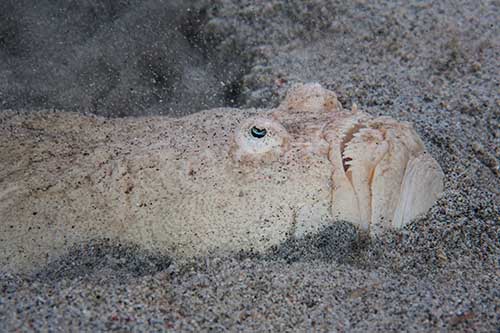
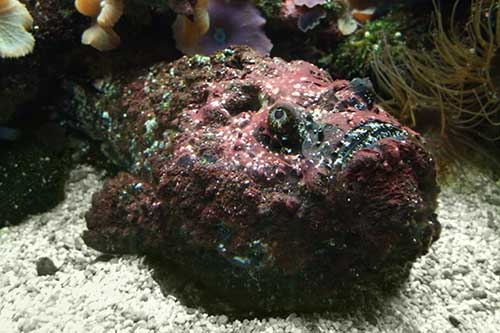
43. Stargazers and stonefish bury themselves to ambush their prey so stay off the bottom to avoid injury. Don’t grab hold of any rock or bit of reef. If you have to hold on to something in an emergency, wave your hand in front of the area and check for movement.
44. If you love the macro stuff and the unusual critters but have trouble finding them, slow down. Find out what they like to eat, where they feel safe and what behavior to look out for; this information will help focus your search. When looking for very small creatures, some divers take magnifying glasses underwater.
45. Don’t forget to look up and around. Amazingly you can be so focused on the reef that you miss the whale shark that cruises passed.
Underwater Photography
46. Perfect your buoyancy first. If you want to perfect your underwater photography, you’ll need capture focused, well-framed images. if you can’t control your position in the water you’ll be struggling.
47. Get close to your subject and fill the frame with it. Think about what is in the image and make sure it doesn’t detract from the subject.
48. Take your time and look for the best composition rather than taking photographs of everything.
49. Know how your camera works in the housing. Practice using it in the housing on land.
50. Shoot up or on the same level as your subject. This technique makes the most of the available light and gives depth to your images.
